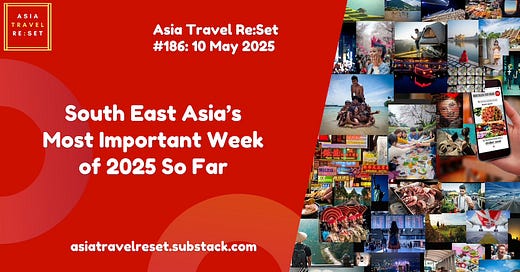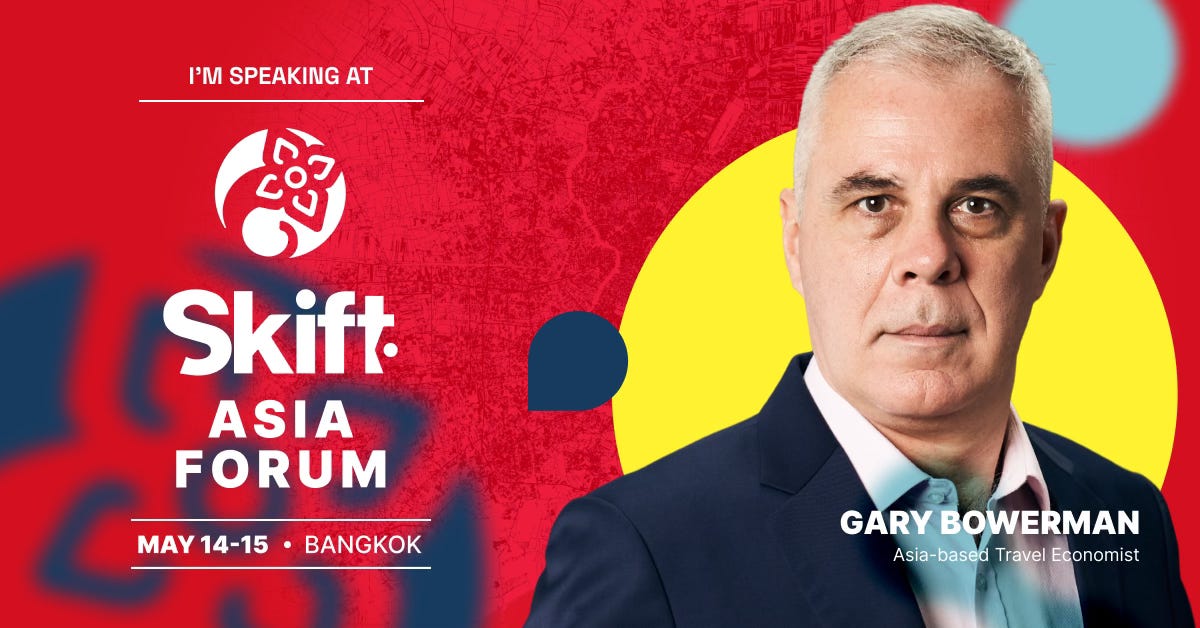Issue #186: South East Asia's Most Important Week of 2025 So Far
Vital trade and conflict negotiations will be closely watched across ASEAN.
Welcome to Issue 186 of Asia Travel Re:Set.
Over the coming days, superpower talks in Geneva, US tariff negotiations with leading Asian economies and war in South Asia will dominate regional attention.
All 3 situations share a common denominator: they will influence South East Asia’s near-term economic trajectory.
Socially shared heat maps of real-time flight paths with gaps over northwest India and Pakistan and a reduced flotilla of Chinese cargo ships sailing to the US, plus jagged currency volatility charts, visualise the developing scale of these man-made challenges.
The urgency for positive intent by Chinese and US trade officials meeting in Switzerland is understood on both sides. Options are stark:
Delay remedial actions and the effects of mutually assured economic demolition will start to accelerate across global markets- with possible stagflation in the US.
Phase a retreat from the cliff’s edge, accept reduced recessionary risks in the US, and save countless businesses from bankruptcy in each nation and across Asia.
Let’s recap those tariff rates on the 10 ASEAN nations which are paused until 9 July: Cambodia 49%. Laos 48%. Vietnam 46%. Myanmar 44%. Thailand 36%, Indonesia 32%. Malaysia 24%. Brunei 24%. Philippines 17%. Singapore 10%.
China-US talks are not taking place in isolation. While US tariffs on China remain high, they will likely stay high for ASEAN countries. Blocking product assembly and trans-shipment workarounds through South East Asia is a US tactic to squeeze China.
Tariff talks between the US and India, Japan, South Korea, Indonesia (ASEAN’s largest economy) and Vietnam (ASEAN’s most dynamic economy), are in play - but it is impossible to delineate any of them from the US-China issue - or from each other.
None of these nations can afford to make the same mistakes as the UK. Having isolated itself via Brexit from its primary trade partner, the EU, the UK had little leverage to counter US trade demands. The resulting terms of its first-mover “deal” will haunt an unpopular government, and create a template for others to avoid.
Currency Spikes & GDP Contractions
In South East Asia, the pressures of trade volatility are building. Thailand and Malaysia this week indicated reduced growth outlooks for 2025. Singapore had previously revised down its GDP growth range from 1-3% to 0-2%, and confronted a fast-rising currency valuation against the US dollar.
In the broader APAC region, currency spikes in Hong Kong and Taiwan forced the respective central banks to intervene.
As the Financial Times noted on Wednesday, “Asian FX is full of drama these days.”
Meanwhile, Indonesia, recorded a quarter-on-quarter contraction of 1%, according to official data - and Vietnam’s Communist Party General Secretary To Lam met Xi Jinping at a banquet in Moscow hosted by Russia’s President Putin.
The upcoming ASEAN Summit in Kuala Lumpur on 26-27 May will be the most consequential edition of the post-Covid era.
Cricket & Conflict
Meantime, suspensions of the Indian Premier League (IPL) and Pakistan Super League (PSL) cricket tournaments underline rising public safety fears in both nations. Both tournaments are hugely popular and lucrative - and attract global stars and audiences.
Some analysts point to previous India-Pakistan conflict outbreaks, notably in 2008, that escalated quickly and were defused before becoming outright war. Nevertheless, the drone-and-missile attacks and aggressive rhetoric from both sides are chilling.
I’ve lost count of the times I’ve said, heard and read “the long-term impacts are still unknown” in recent weeks, but the next 7 days may give us clearer indicators.
Or, indeed, they may not.
Thanks for checking in…
It’s not easy to segue between intra-APAC air capacity, Chinese and Indian outbound, aircraft supply chains, US tariffs and the India-Pakistan conflict and shifting patterns of luxury travel, domestic Thai tourism, and the 2025 outlook for leisure and business travel in ASEAN markets... in 30 minutes.
But somehow, we managed it at the Travel Daily Media Travel Trade Summit 2025 in Bangkok on Thursday.
During the session, we polled delegates on the following question:
Which market are you watching closest with regard to travel sentiment in 2025: China, India, US, Malaysia, Thailand Domestic?
The resounding answer... ?
India.
Many thanks to a brilliant panel, Deepshikha Sehgal, Head of Lodging, Ground & Sea APAC, Sabre Corporation, Patee Sarasin, CEO, Really Cool Airlines, and Marga Manlapig, Senior Editor, Travel Daily Media - TDM
This week, the Skift Asia Forum 2025 returns to South East Asia after a 6-year absence. I’ll be joining the 𝐃𝐢𝐯𝐞𝐫𝐬𝐢𝐟𝐲𝐢𝐧𝐠 𝐀𝐬𝐢𝐚’𝐬 𝐓𝐫𝐚𝐯𝐞𝐥 𝐅𝐮𝐭𝐮𝐫𝐞 panel in Bangkok with Fazal Bahardeen and Hannah Pearson, moderated by Peden Doma Bhutia.
In advance, check out the Skift Travel Podcast (click below), as Hannah and I chat with Skift CEO/Founder Rafat Ali about the travel outlook in ASEAN and Asia Pacific.
152 billion. 800 million. 201,083. 40,000. South East Asia comprises 10 diverse nations and nearly 700 million people across a vast region. Consequently, travel-related statistics are often large, impactful and scaleable.
On this week’s The South East Asia Travel Show, Hannah and I assess the Top 8 statistical talking points in May.
These include:
International airline seat capacity: ASEAN vs APAC.
The Hajj pilgrimage from Indonesia.
A human resources deficit in Vietnam.
Power output risks of electrified living everywhere.
Plus,
Which capital city is spending USD200 million on urban heritage revitalisation?
Which ASEAN nation is surging ahead for year-on year arrivals growth?
And, can Love Win All in Thailand?
Click on the live link below to listen to From 40,000 to 152 Billion: South East Asia’s Top 8 Travel & Tourism Statistical Talking Points
Or search for The South East Asia Travel Show on any podcast app.
And, that’s a wrap for Issue 186.
Asia Travel Re:Set is taking a break next Sunday, but will return in two weeks’ time. Meantime, find me on LinkedIn.
Happy travels,
Gary







